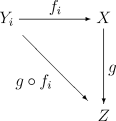Symplectic vector field
In general topology and related areas of mathematics, the final topology (or strong topology or colimit topology or projective topology) on a set , with respect to a family of functions into , is the finest topology on X which makes those functions continuous.
The dual notion is the initial topology.
Definition
Given a set and a family of topological spaces with functions
the final topology on is the finest topology such that each
is continuous.
Explicitly, the final topology may be described as follows: a subset U of X is open if and only if is open in Yi for each i ∈ I.
Examples
- The quotient topology is the final topology on the quotient space with respect to the quotient map.
- The disjoint union is the final topology with respect to the family of canonical injections.
- More generally, a topological space is coherent with a family of subspaces if it has the final topology coinduced by the inclusion maps.
- The direct limit of any direct system of spaces and continuous maps is the set-theoretic direct limit together with the final topology determined by the canonical morphisms.
- Given a family of topologies {τi} on a fixed set X the final topology on X with respect to the functions idX : (X, τi) → X is the infimum (or meet) of the topologies {τi} in the lattice of topologies on X. That is, the final topology τ is the intersection of the topologies {τi}.
- The etale space of a sheaf is topologized by a final topology.
Properties
A subset of is closed/open if and only if its preimage under fi is closed/open in for each i ∈ I.
The final topology on X can be characterized by the following universal property: a function from to some space is continuous if and only if is continuous for each i ∈ I.

By the universal property of the disjoint union topology we know that given any family of continuous maps fi : Yi → X there is a unique continuous map
If the family of maps fi covers X (i.e. each x in X lies in the image of some fi) then the map f will be a quotient map if and only if X has the final topology determined by the maps fi.
Categorical description
In the language of category theory, the final topology construction can be described as follows. Let Y be a functor from a discrete category J to the category of topological spaces Top which selects the spaces Yi for i in J. Let Δ be the diagonal functor from Top to the functor category TopJ (this functor sends each space X to the constant functor to X). The comma category (Y ↓ Δ) is then the category of cones from Y, i.e. objects in (Y ↓ Δ) are pairs (X, f) where fi : Yi → X is a family of continuous maps to X. If U is the forgetful functor from Top to Set and Δ′ is the diagonal functor from Set to SetJ then the comma category (UY ↓ Δ′) is the category of all cones from UY. The final topology construction can then be described as a functor from (UY ↓ Δ′) to (Y ↓ Δ). This functor is left adjoint to the corresponding forgetful functor.
See also
References
- Stephen Willard, General Topology, (1970) Addison-Wesley Publishing Company, Reading Massachusetts. (Provides a short, general introduction)









